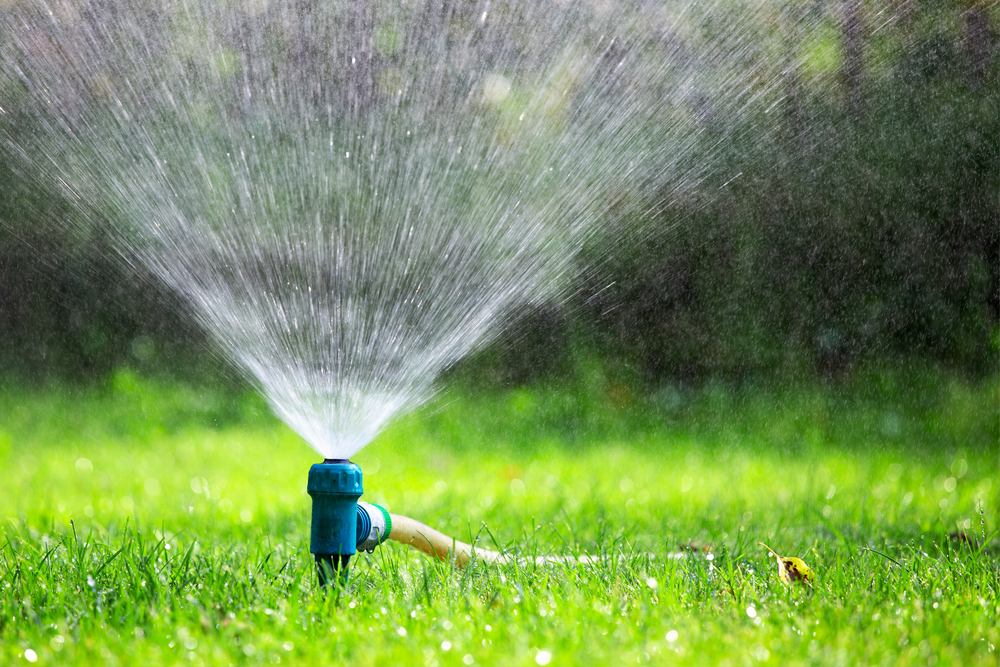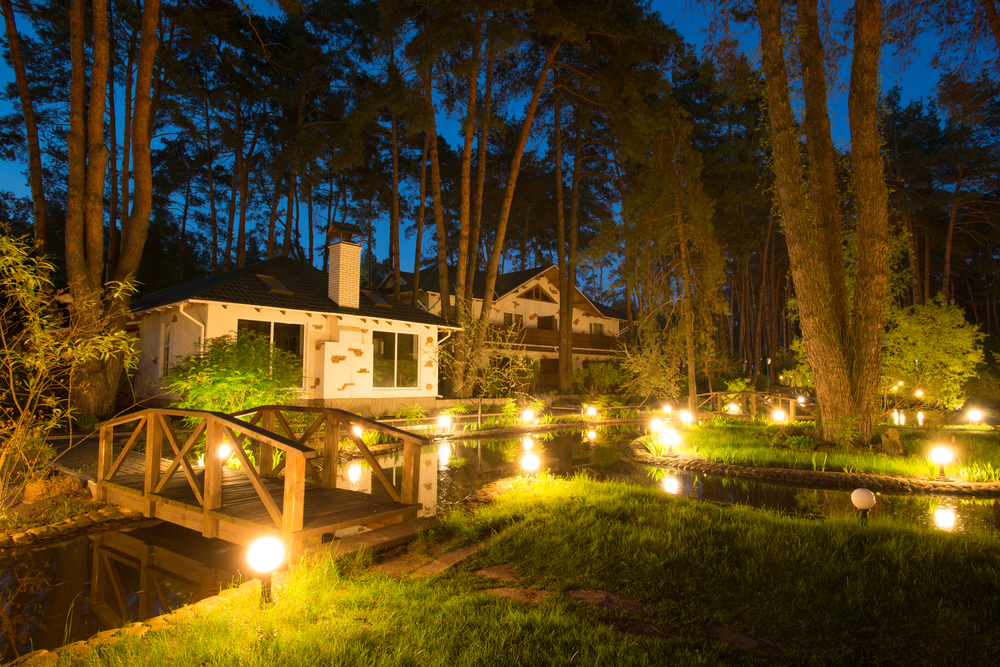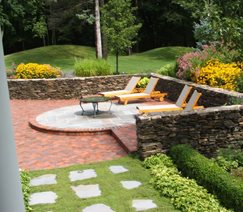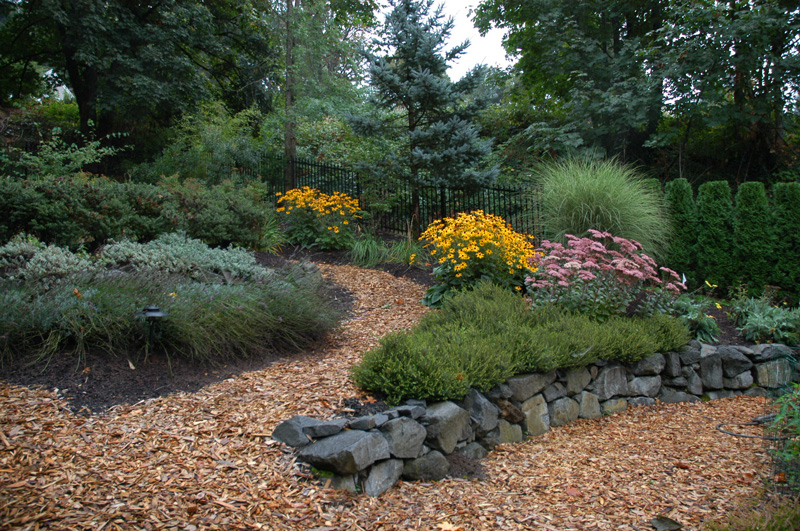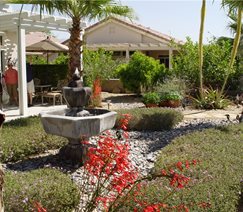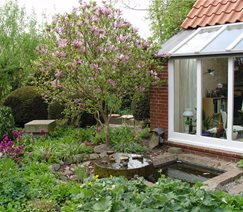Low Voltage Landscape Lighting
Low Voltage Landscape Lighting is an afterthought for most homeowners, but professional landscapers consider it one of the most important elements in the landscape. “We use lighting for three purposes,” says TJ Wilcoxson of Alexon Design Group in Gilbert, AZ. “To create atmosphere, provide safety by repelling burglars or vandals, and to light the way on paths, patios, and other places we spend time in the landscape.” Here, professional landscape contractors share their tips on using landscape lighting effectively.
Up until 2010, the majority of landscape contractors were using halogen lights, which provide a warm glow and great quality of light. Yet with the recent advances in LED lighting, most contractors have converted their operations to energy-efficient LEDs. Solar lights, by contrast, aren’t currently recommended by professionals.
Halogen lighting
Pros:
“Halogen lighting has a warm, amber glow that makes everything look good,” says Wilcoxson. Gerry DuBreuil of Belknap Landscape Company, Inc. of Gilford, NH agrees. “Until recently, we were primarily using halogen and incandescent lighting because of the light quality.”
Cons:
Unfortunately, halogen lighting costs more to run than LED. “Choosing LEDs over halogen will save you 60-70% of your energy costs each month,” says Wilcoxson. Halogen lights also require more maintenance. As Matt Barton of Coppercreek Landscaping, Inc. in Mead, WA points out, “Halogen bulbs need replacing every 8-12 months, depending on how long the system runs each day. Compare that to LEDs which have a 10-year bulb life, and LEDs look like a set-it-and-forget-it solution.” Halogen lights can also run hot, which means lights must be placed carefully so plants are not brushed up against the fixture or bulb.
When having low-voltage landscape lighting installed you may hear your contractor use these terms:
- Low Voltage Transformer: A transformer converts line voltage power from a dangerous 120 volts down to 12 volts.
- Direct burial cable: Low voltage cable can be direct burial cable meaning it does not require placement in a conduit when set underground.. The longer the run the heavier your cable should be. Line loss occurs more readily in smaller cables. Plan your system with 12-2 twisted pair wiring for typical runs and 10-2 or even 8-2 for runs over 100 feet.
- Line loss: Low Voltage electrical systems are very susceptible to “line loss”, the voltage drop caused by resistance in wire during transmission of electrical power over distance.
- Watts: A watt is a measurement of total electrical power. Volts x amps = watts
- Cable Load: Cable load defines how many watts can be on any one cable. Plan for 100 watts on 12-2, 150 watts on 10-2 and up to 200 watts on 8-2.
LED lighting
Pros:
Most professionals use LEDs almost exclusively now. “Our clientele are asking for LEDs more and more,” says DuBreuil. The obvious benefits are those of cost and maintenance savings over time. LED bulbs generally have a 10-year warranty so you rarely need to replace them, and the monthly cost to run is much less than halogen. “They’re eco-friendly,” says DuBreuil.
But there are other benefits, too. “LED bulbs have a very crisp light that really brings out the features of a home or landscape,” says DuBreuil. LED bulbs are available in warm white, white, and cool white tones. “The cool white has a bluish tone most people dislike,” DuBreuil continues. “I generally use warm white bulbs.”
Barton points out that because of the energy efficiency, LEDs can be easier for your landscaper to install. “You can use more lights on a run, or even use a smaller transformer which saves money. It takes a lot less wiring and labor time to install LEDs compared to halogen.”
LED bulbs also stay cool, which means you can nestle a plant next to your LED fixture without worrying about burning the foliage.
Cons:
Most of the cons of LED lighting are in the past. “LEDs have come leaps and bounds in the last couple of years in terms of quality of light and fixtures,” says DuBreuil. While the LED bulbs of the past were a cold bluish-white, now the bulbs are available in warmer tones that feel more welcoming in the landscape. In addition, manufacturers have begun offering well-designed, professional-grade fixtures that last well in the landscape.
The price of bulbs is another consideration. “LED bulbs can run $30-40 each,” says Wilcoxson, “while halogen bulbs are only about $6.” Yet the ease of installing LEDs means that the higher cost often balances out in labor savings.
Placement in the landscapeIn a new landscape, once you have a written landscaping plan it’s easy for a professional to recommend some high-impact locations for lighting. Some of the best locations will be specific to your particular landscape, but there are a few common places that work well when lit.
- Pathways and steps – “We call this traverse lighting because it helps you get from one place to another,” says Wilcoxson.
- Decks and patios – Similarly, patio lighting is called “converse”. “This type of lighting allows you to enjoy conversation and company,” Wilcoxson says. “When you chat with friends, you want to be able to see them.”
- Home and architecture – Barton suggests lighting your front entry, pillars and stone veneer.
- Water features – “There are underwater lights available that highlight the rippling water in a simple, classic way,” says Barton.
- Driveway – Few lights are needed on the driveway, since we all have headlights. The best tactic for lighting a driveway is to light the landscape alongside.
- Trees – Uplighting into trees creates bold shadows in the landscape, while downlighting from the top of a tree mimics the romantic effect of moonlight.
- Patio covers and pergolas – “A chandelier light fixture overhead feels inviting and creates ambience,” says Barton.
Budget-friendly lightingWhile landscape lighting is one of the first things to get thrown out when the budget is tight, landscapers urge you to reconsider. “Here in Arizona, we don’t sit outside in the afternoon. It’s just too hot,” says Wilcoxson. “But as soon as the sun goes down, you can have barbecues, night-time parties, or just sit quietly outside enjoying the landscape. Good lighting lets you actually use your landscape.” If the budget doesn’t allow for a full lighting installation, you can either break the project into two stages, or just choose a few key locations to light.
Barton suggests that if you can’t afford lighting right now, “at least pre-wire it so if you install it later, your landscaper won’t have to dig up your sod and beautiful landscape.” When your landscape is all dug up and in the construction phase, it takes very little effort to run wiring throughout the landscape. Once you lay sod and your shrubs have filled in, digging up the landscape to add wire takes a lot more time and money. “I would 100% encourage people to pre-wire; it saves so much money for them in the end,” says Barton.
If you’d like to install lighting right now but need to keep it minimal, there are a few areas to consider first.
- Pathways and patios – “The functional areas always come first,” says Barton. This lets you actually spend time in your landscape after dark.
- Architectural features – DuBreuil suggests putting the focus on your home. “Pillars, stone and veneer make beautiful shadows and cast indirect light into the landscape,” he says.
- Focal areas – Every landscape will have its own unique features. Old twisting trees, waterfalls, or spiky plants are all dramatic candidates for lighting.
SOURCE: Landscaping Network

